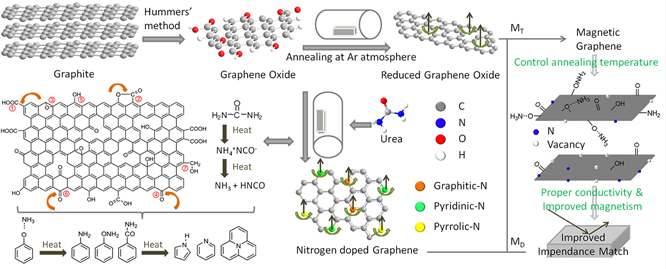Abstract
By synthesizing nitrogen-doped graphene (NG) via a facile thermal annealing method, a fine control of the amount and location of doped nitrogen as well as the oxygen-containing functional groups is achieved with varying annealing temperature. The favorable magnetic properties have been achieved for N-doped rGO samples obtained at two temperatures of all NG samples, i.e., 500oC and 900oC with saturation magnetization of 0.63emu/g and 0.67emu/g at 2K, respectively. This is attributed to the optimized competition of the N-doping and reduction process at 500oC and the dominated reduction process at 900oC. NG obtained at 300oC affords the best overall absorbing performance: when the absorber thickness is 3.0mm, the maximum absorption was -24.6dB at 8.51GHz, and the absorption bandwidth was 4.89 GHz (7.55 GHz ~ 12.44 GHz) below -10dB. It owes its large absorbing intensity to the good impedance match and significant dielectric loss. The broad absorption bandwidth benefits from local fluctuations of dielectric responses contributed by competing mechanisms. Despite the significant contribution from materials loss to the absorption, the one quarter-wavelength model is found to be responsible for the RL peak positions. Of particular significance is that an appropriate set of electromagnetic parameters associated with reasonable reduction is readily accessible by convenient control of annealing temperature to modulate the microwave absorbing features of graphene. Thus, nitrogen-doped graphene prepared by thermal annealing promises to be a highly efficient microwave absorbent.

Quan L, Qin F, Li Y, et al. Magnetic graphene enabled tunable microwave absorber via thermal control.[J]. Nanotechnology, 2018, 29(24).


